

Developer Interface — Requests 2.7.0 documentation. This part of the documentation covers all the interfaces of Requests.
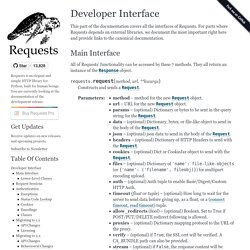
For parts where Requests depends on external libraries, we document the most important right here and provide links to the canonical documentation. Main Interface All of Requests’ functionality can be accessed by these 7 methods. They all return an instance of the Response object. requests.request(method, url, **kwargs) Advanced Usage — Requests 2.7.0 documentation. This document covers some of Requests more advanced features.
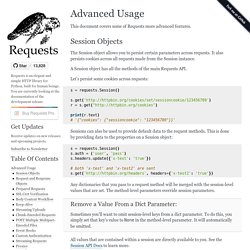
Session Objects The Session object allows you to persist certain parameters across requests. It also persists cookies across all requests made from the Session instance. A Session object has all the methods of the main Requests API. Let’s persist some cookies across requests: Sessions can also be used to provide default data to the request methods. Any dictionaries that you pass to a request method will be merged with the session-level values that are set. Requests: HTTP for Humans — Requests 2.7.0 documentation. Beautiful Soup Documentation — Beautiful Soup 4.2.0 documentation.
Beautiful Soup is a Python library for pulling data out of HTML and XML files.
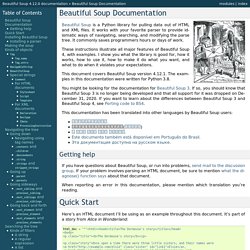
It works with your favorite parser to provide idiomatic ways of navigating, searching, and modifying the parse tree. It commonly saves programmers hours or days of work. These instructions illustrate all major features of Beautiful Soup 4, with examples. I show you what the library is good for, how it works, how to use it, how to make it do what you want, and what to do when it violates your expectations. The examples in this documentation should work the same way in Python 2.7 and Python 3.2. You might be looking for the documentation for Beautiful Soup 3.
This documentation has been translated into other languages by Beautiful Soup users: 这篇文档当然还有中文版.このページは日本語で利用できます(外部リンク)이 문서는 한국어 번역도 가능합니다. Here’s an HTML document I’ll be using as an example throughout this document. Here are some simple ways to navigate that data structure: One common task is extracting all the URLs found within a page’s <a> tags: Tag Name.
Beautiful Soup: We called him Tortoise because he taught us. [ Download | Documentation | Hall of Fame | For enterprise | Source | Changelog | Discussion group | Zine ] You didn't write that awful page. You're just trying to get some data out of it. Beautiful Soup is here to help. Since 2004, it's been saving programmers hours or days of work on quick-turnaround screen scraping projects. Beautiful Soup is a Python library designed for quick turnaround projects like screen-scraping. Beautiful Soup provides a few simple methods and Pythonic idioms for navigating, searching, and modifying a parse tree: a toolkit for dissecting a document and extracting what you need. Beautiful Soup parses anything you give it, and does the tree traversal stuff for you. Valuable data that was once locked up in poorly-designed websites is now within your reach.
Interested? Getting and giving support. I Don’t Need No Stinking API: Web Scraping For Fun and Profit. If you’ve ever needed to pull data from a third party website, chances are you started by checking to see if they had an official API.
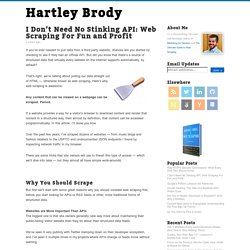
But did you know that there’s a source of structured data that virtually every website on the internet supports automatically, by default? That’s right, we’re talking about pulling our data straight out of HTML — otherwise known as web scraping. Here’s why web scraping is awesome: Any content that can be viewed on a webpage can be scraped. Period. If a website provides a way for a visitor’s browser to download content and render that content in a structured way, then almost by definition, that content can be accessed programmatically.
Over the past few years, I’ve scraped dozens of websites — from music blogs and fashion retailers to the USPTO and undocumented JSON endpoints I found by inspecting network traffic in my browser. Why You Should Scrape With APIs, you often have to register to get a key and then send along that key with every request. Ultimate Guide to Web… by Hartley Brody. Hopefully you learned a thing or two from my article I Don’t Need No Stinking API: Web Scraping For Fun and Profit.
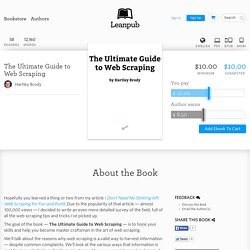
Due to the popularity of that article — almost 100,000 views — I decided to write an even more detailed survey of the field, full of all the web scraping tips and tricks I've picked up. The goal of the book — The Ultimate Guide to Web Scraping — is to hone your skills and help you become master craftsman in the art of web scraping. We'll talk about the reasons why web scraping is a valid way to harvest information — despite common complaints. We'll look at the various ways that information is sent from a website to a client's computer, and how you can intercept and parse it. We'll also look at common traps and anti-scraping tactics and how you might be able to thwart them.